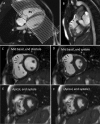Recommendations for cardiovascular magnetic resonance in adults with congenital heart disease from the respective working groups of the European Society of Cardiology
- PMID: 20067914
- PMCID: PMC2848324
- DOI: 10.1093/eurheartj/ehp586
Recommendations for cardiovascular magnetic resonance in adults with congenital heart disease from the respective working groups of the European Society of Cardiology
Abstract
This paper aims to provide information and explanations regarding the clinically relevant options, strengths, and limitations of cardiovascular magnetic resonance (CMR) in relation to adults with congenital heart disease (CHD). Cardiovascular magnetic resonance can provide assessments of anatomical connections, biventricular function, myocardial viability, measurements of flow, angiography, and more, without ionizing radiation. It should be regarded as a necessary facility in a centre specializing in the care of adults with CHD. Also, those using CMR to investigate acquired heart disease should be able to recognize and evaluate previously unsuspected CHD such as septal defects, anomalously connected pulmonary veins, or double-chambered right ventricle. To realize its full potential and to avoid pitfalls, however, CMR of CHD requires training and experience. Appropriate pathophysiological understanding is needed to evaluate cardiovascular function after surgery for tetralogy of Fallot, transposition of the great arteries, and after Fontan operations. For these and other complex CHD, CMR should be undertaken by specialists committed to long-term collaboration with the clinicians and surgeons managing the patients. We provide a table of CMR acquisition protocols in relation to CHD categories as a guide towards appropriate use of this uniquely versatile imaging modality.
Figures


References
-
- Pennell DJ, Sechtem UP, Higgins CB, Manning WJ, Pohost GM, Rademakers FE, van Rossum AC, Shaw LJ, Yucel EK. Clinical indications for cardiovascular magnetic resonance (CMR): Consensus Panel report. Eur Heart J. 2004;25:1940–1965. - PubMed
-
- Perloff JK, Warnes CA. Challenges posed by adults with repaired congenital heart disease. Circulation. 2001;103:2637–2643. - PubMed
-
- Dearani JA, Connolly HM, Martinez R, Fontanet H, Webb GD. Caring for adults with congenital cardiac disease: successes and challenges for 2007 and beyond. Cardiol Young. 2007;17:87–96. - PubMed
-
- Niwa K, Perloff JK, Webb GD, Murphy D, Liberthson R, Warnes CA, Gatzoulis MA. Survey of specialized tertiary care facilities for adults with congenital heart disease. Int J Cardiol. 2004;96:211–216. - PubMed
-
- Warnes CA. Transposition of the great arteries. Circulation. 2006;114:2699–2709. - PubMed
Publication types
MeSH terms
Grants and funding
LinkOut - more resources
Full Text Sources
Other Literature Sources
Medical

